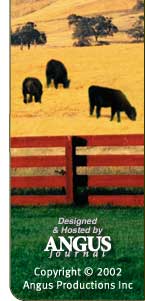| Beal demonstrates the estrous cycle. |
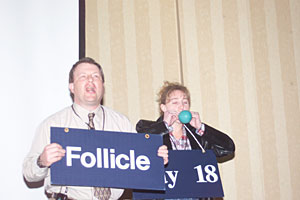 |
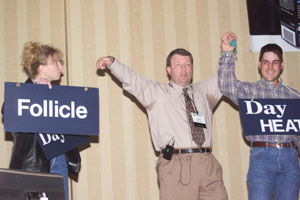 |
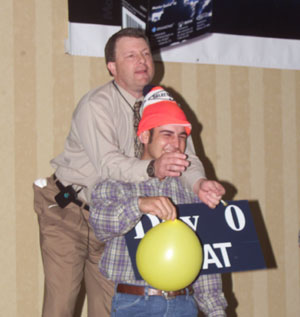 |
The Value of Getting Them Bred
by Bill Beal, Virginia Tech
Click here to listen to the presentation
You will need Windows Media Player to listen in.
Click here to download a free version.
Reproduction is “dynamic.” The processes of ovum and sperm production, fertilization, embryo development and parturition in cattle are simply fascinating. Furthermore, reproductive efficiency is the most economically-important trait in livestock production. Therefore, understanding of reproductive anatomy and physiology is essential for achieving maximum reproductive efficiency and improving financial management of beef herds.
The most important objectives for understanding reproduction of beef cows are:
• To become familiar with the female reproductive tract
• To understand the events of the estrous cycle and pregnancy
Perhaps the most important of these objectives is understanding the events, timing and hormonal controls of the estrous cycle. Understanding the estrous cycle is key to explaining the things that must “go right” to establish a pregnancy or the things that may “go wrong” if a female fails to become pregnant or experiences embryonic mortality.
Female Reproductive Tract
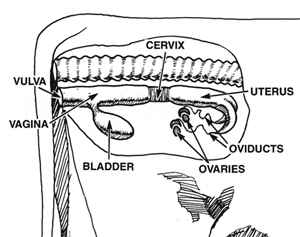 First, consider the parts that make up the female reproductive system in cattle. There are two ovaries, two oviducts, two uterine horns, a uterine body, the cervix, the vagina, and the vulva. The bladder lies below the reproductive tract and is connected at the urethral opening on the vaginal floor. The rectum is located above the reproductive system. First, consider the parts that make up the female reproductive system in cattle. There are two ovaries, two oviducts, two uterine horns, a uterine body, the cervix, the vagina, and the vulva. The bladder lies below the reproductive tract and is connected at the urethral opening on the vaginal floor. The rectum is located above the reproductive system.
The vulva is the opening to the reproductive system. Its three functions are the passage of urine, the opening for mating, and it serves as the birth canal. Included in this structure are the lips, vestibule and clitoris. The vulval lips are located at the opening and appear wrinkled and dry when the cow is not in heat. One of the secondary signs of heat is swelling of the vulva along with a moist red appearance.
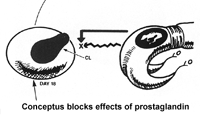 The vagina, about 4 to 5 inches in length, extends from the urethral opening to the cervix. This is the site where semen is deposited during natural mating. Cells in the vagina and cervix secrete mucus that lubricates the tract during insemination. The vagina, about 4 to 5 inches in length, extends from the urethral opening to the cervix. This is the site where semen is deposited during natural mating. Cells in the vagina and cervix secrete mucus that lubricates the tract during insemination.
The cervix is a thick–walled organ forming a connection between the vagina and uterus. The cervical opening protrudes back into the vagina. The cervix itself is made of very dense connective tissue. Thick folds and rings in the center of the cervix overlap, making an effective barrier between the uterus and vagina. The cervix opens into the body of the uterus.
About an inch long, the body of the uterus serves as a connection between the two uterine horns. This is where semen is usually deposited during artificial insemination. From this point, the reproductive tract separates and all further structures described, come in pairs. The two uterine horns consist of layers of muscle and a heavy network of blood vessels. When a cow is bred either naturally or by artificial insemination, the uterine muscles, under the influence of the hormone, oxytocin, rhythmically contract. Further contraction by muscles of the oviduct help move semen to the site of fertilization, the middle of the oviduct.
Oviducts, as their name implies, carry ova, the cow’s eggs. Ova are caught by the large open end of the oviduct that surrounds the ovary. This funnel-like structure called the infundibulum, keeps the ova from falling into the body cavity. Hair-like structures carry the ova down the oviduct to the site of fertilization. After fertilization, the embryo travels down the oviduct and arrives in the uterus within 4-5 days.
The ovaries are the primary organs in a cow’s reproductive tract. They have two functions: to produce ova (eggs); and to produce hormones such as estrogen and progesterone throughout the different stages of the estrous cycle.
The Estrous Cycle
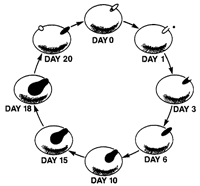 Over a period of time, many changes take place in the reproductive system. These changes in non-pregnant, normal cows repeat every 21 days. This regular repetition is called the estrous cycle. Over a period of time, many changes take place in the reproductive system. These changes in non-pregnant, normal cows repeat every 21 days. This regular repetition is called the estrous cycle.
 Consider the estrous cycle as beginning when the cow is in heat on day zero. Looking at the reproductive tract, several things are happening. One ovary has a large follicle with a blister like appearance. This follicle, filled with a fluid, has a mature egg ready to be released. Consider the estrous cycle as beginning when the cow is in heat on day zero. Looking at the reproductive tract, several things are happening. One ovary has a large follicle with a blister like appearance. This follicle, filled with a fluid, has a mature egg ready to be released.
The follicle is also producing the hormone estrogen. Estrogen, transported in the blood to all parts of the cow’s body, causes other organs to react in a number of ways. It makes the uterus sensitive to stimulation and aids in the transport of semen at the time of insemination. It causes the cervix to secrete a viscous mucus that flows and lubricates the vagina. Estrogen is also responsible for several signs of heat in a cow; a red swollen vagina, allowing other cows to mount her, going off feed, bellowing and holding her ears erect.
 On day one, the follicle breaks, releasing the egg into the oviduct. In the oviduct the egg awaits sperm for fertilization. By the time the follicle has broken, most cows will have quit producing estrogen. As a result, the cow no longer displays the familiar signs of heat. On day one, the follicle breaks, releasing the egg into the oviduct. In the oviduct the egg awaits sperm for fertilization. By the time the follicle has broken, most cows will have quit producing estrogen. As a result, the cow no longer displays the familiar signs of heat.
New types of cells, luteal cells, grow in the void on the ovary where the follicle was located. Quite rapidly over the next five to six days, the corpus luteum or CL grows.
The CL produces another hormone, progesterone. Progesterone makes the uterus ready to accept a fertilized egg and keeps the cow from coming in heat. Under the influence of progesterone, the uterus produces a nourishing substance for the embryo to grow on. At the same time, a thick plug forms in the cervix, preventing any bacteria or viruses from entering the uterus.
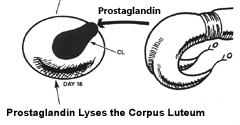 Progesterone also blocks the release of follicle stimulating hormone (FSH) from the pituitary gland. This keeps a pregnant cow from coming back in heat every three weeks, which would make life difficult for a new embryo. On the other hand, if the cow is not pregnant, we do want her to come in heat again.
Progesterone also blocks the release of follicle stimulating hormone (FSH) from the pituitary gland. This keeps a pregnant cow from coming back in heat every three weeks, which would make life difficult for a new embryo. On the other hand, if the cow is not pregnant, we do want her to come in heat again.
Sixteen or seventeen days after the cow was in heat, if the uterus does not detect a growing embryo, it begins to produce another hormone called prostaglandin. Prostaglandin begins to destroy the CL.
With the CL gone, no more progesterone is produced and the pituitary gland begins to secrete FSH, which goes to the ovary.
This follicle stimulating hormone initiates the development of a new follicle. The new follicle grows, producing large amounts of estrogen and brings the cow back into heat. A full cycle is now completed. The average total time is about 21 days with a normal range of 18-24 days.
Embryo and fetal development
Compare the events during the estrous cycle with those that occur if the cow is inseminated and becomes pregnant. For the first four to five days, the embryo would move in the oviduct toward the uterus. Once it enters the uterus, the embryo would be bathed in uterine fluids and continue growing, while floating free in the uterus for about 30 days.
 If the cow is pregnant, the events of the estrous cycle would be the same as those of the non-pregnant animal until day 16 or 17. An embryo present in the uterus at that time will produce a substance which interferes with the ability of prostaglandin to destroy the CL. Thus, the CL is not destroyed and remains on the ovary producing large amounts of progesterone to support embryo development and prevent the cow from coming back into heat. This CL will remain on the ovary until the cow is at or near calving.
If the cow is pregnant, the events of the estrous cycle would be the same as those of the non-pregnant animal until day 16 or 17. An embryo present in the uterus at that time will produce a substance which interferes with the ability of prostaglandin to destroy the CL. Thus, the CL is not destroyed and remains on the ovary producing large amounts of progesterone to support embryo development and prevent the cow from coming back into heat. This CL will remain on the ovary until the cow is at or near calving.
Several membranes, including the amnion, the chorion and allantois are produced by the new embryo, and become attached to the uterus at several points. These points of attachment are called placentomes. They allow the calf to get nutrients from the mother and dispose of wastes by arteries and veins going in and out through the umbilical cord.
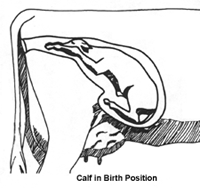 At calving, the muscles in the uterus begin to contract and eventually expel the calf and membranes through a dilated cervix and vagina. Several hormones including progesterone, estrogen, prolactin and corticoids produced by the mother, the fetus, and the placenta, interact to bring about this event.
At calving, the muscles in the uterus begin to contract and eventually expel the calf and membranes through a dilated cervix and vagina. Several hormones including progesterone, estrogen, prolactin and corticoids produced by the mother, the fetus, and the placenta, interact to bring about this event.
Calving in a clean environment and proper treatment of the cow after a difficult calving will help prevent reproductive problems. Becoming familiar with the reproductive anatomy and physiology of a cow helps all producers do a better job in the reproductive management of their herd.
Timed insemination programs for cattle
The evolution of estrous synchronization programs has been a continuous process for the past 50 years. Within that continuous process there have been flurries of activity centered around the availability of new pharmaceutical products or new research methods, like ultrasonography. In the last 15 years the use of ultrasound has enabled us to understand the wave-like development of follicles that occurs during the estrous cycle. At the same time we have learned to control or synchronize those “follicular waves” through the use of gonadotropin-releasing hormone (GnRH). The ability to synchronize follicular development in a group of cows prior to using prostaglandin (Lutalyse ®, Estumate ® or Prostamate ®) to synchronize estrus is the key to the elimination of heat detection and a successful timed insemination program.
Follicular waves
Development of follicles during the bovine estrous cycle occurs in waves of growth during which several follicles begin growing until a single, dominant follicle (DF) becomes larger than subordinate follicles (Figure 1). The dominant follicle inhibits growth of other follicles. Over time the DF loses the ability to inhibit other follicles and a new follicular wave is initiated. However if the corpus luteum has regressed (end of cycle), then the DF matures and ovulates. Estrous cycles of most cows consist of two or three waves of follicular development with the last wave giving rise to the ovulatory follicle.

Figure 1 (above).
Schematic diagram of waves of follicular growth during the bovine estrous cycle (A, 2-wave cycle; B, 3-wave cycle; arrows indicate time of ovulation). Lines with open symbols represent the dominant follicle and lines with solid symbols represent one of the many subordinate follicles.
Gonadatropin-releasing hormone
GnRH is a naturally-occurring hormone that causes the release of luteinizing hormone (LH). GnRH is sold as a pharmaceutical product under the tradenames: Cystorelin ®, Fertagyl ® or Factrel ®.
The injection of GnRH and the LH surge that follows causes the dominant follicle to ovulate and form a luteal structure (like the CL). If GnRH is administered during the cycle, the DF is not mature and breeding would be unsuccessful, but a new follicular wave is initiated. If the CL has been regressed by administering prostaglandin, the injection of GnRH will cause a timed ovulation that is fertile.
Given the different responses of follicles to GnRH, the drug can be used as a tool for estrous cycle control in either of two ways:
If a CL is present: GnRH induces a new wave of follicles, or
If a CL is not present: GnRH will induce ovulation 27 hours later
Controlling the time of emergence of a new follicular wave and synchronizing the follicular wave status of animals within a group is the newest technique used to improve the synchrony of estrus and precise timing of ovulation. Treatment of all animals at the beginning of an estrus synchronization treatment induces the synchronous emergence of a new DF such that at the end of the treatment (usually 7-9 days later) all animals in the group have a DF at the same stage of development. When the CL is regressed, by prostaglandin administration, the synchrony of estrus is remarkably “tight” and the option of inducing a timed ovulation is more realistic because all animals in the group have a large follicle at the same stage of development.
The most popular estrus synchronization/ ovulation control treatment that combines the use of GnRH and prostaglandin is called “Ovsynch.”

Ovsynch incorporates one GnRH injection 7 days prior to prostaglandin (synchronization of follicular development) with a second GnRH injection (ovulation control) 48 hours after prostaglandin-induced regression of the CL. The system is expensive and labor intensive (3 to 4 time handling), but it eliminates the need for heat detection. All animals are bred at 8-18 hours after the second GnRH injection. The system will induce estrus and ovulation in some non-cycling cows. Pregnancy rates for dairy cows usually range from 25 to 45% following Ovsynch treatment.
welcome : conference schedule : tour schedule : conference speakers : info
|




